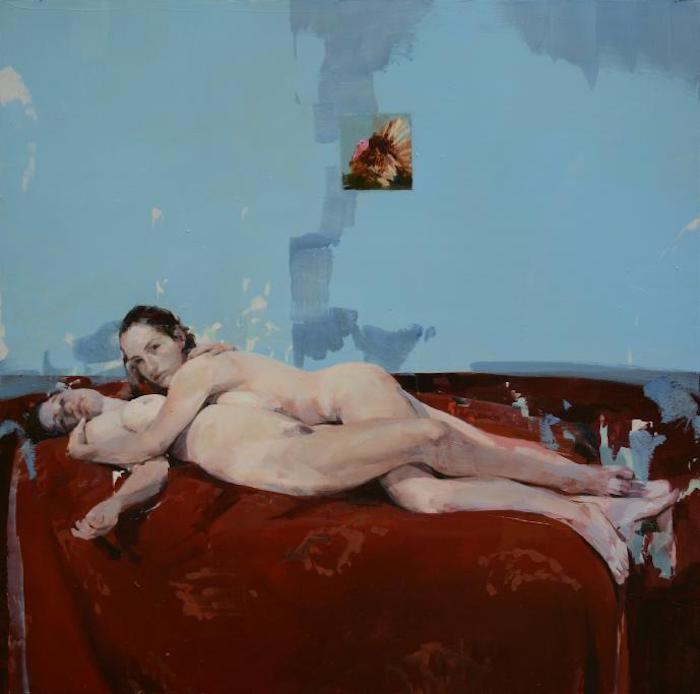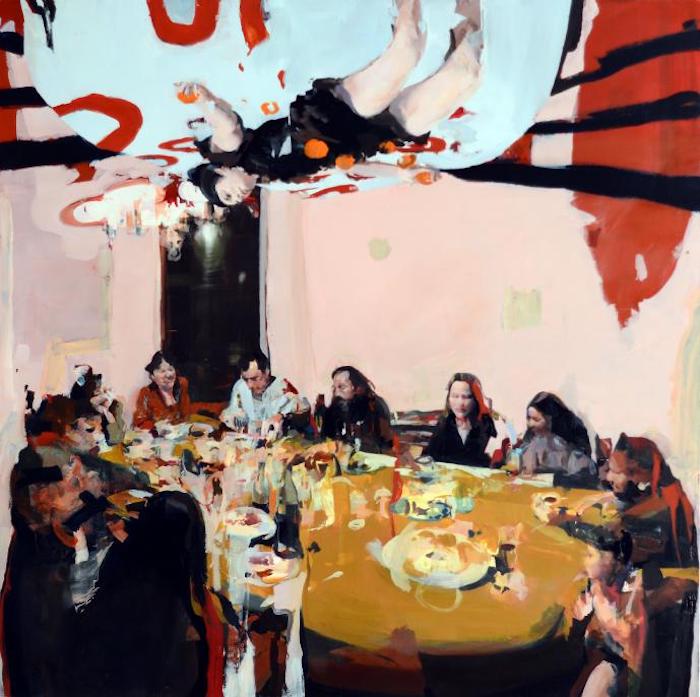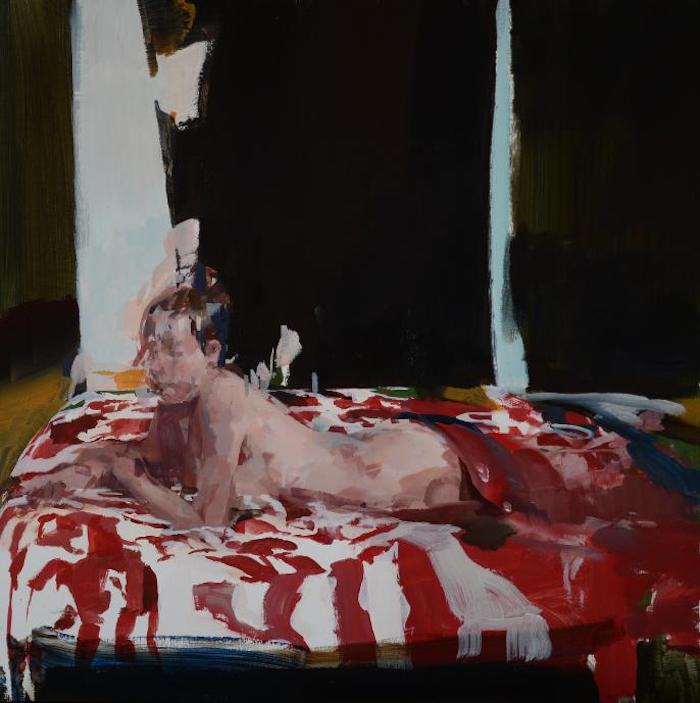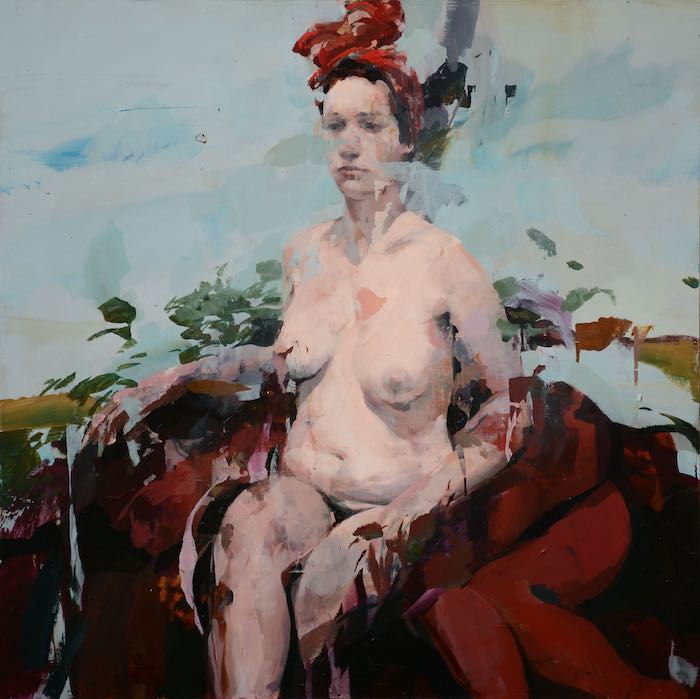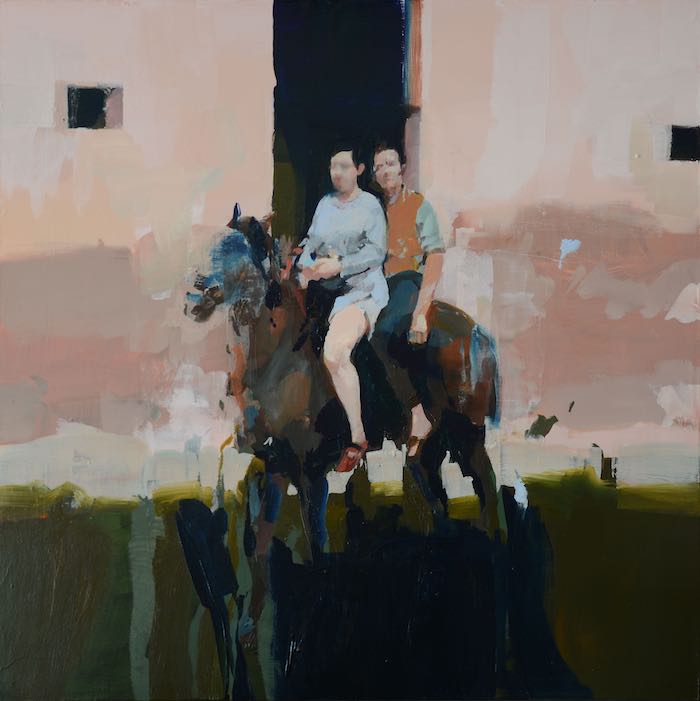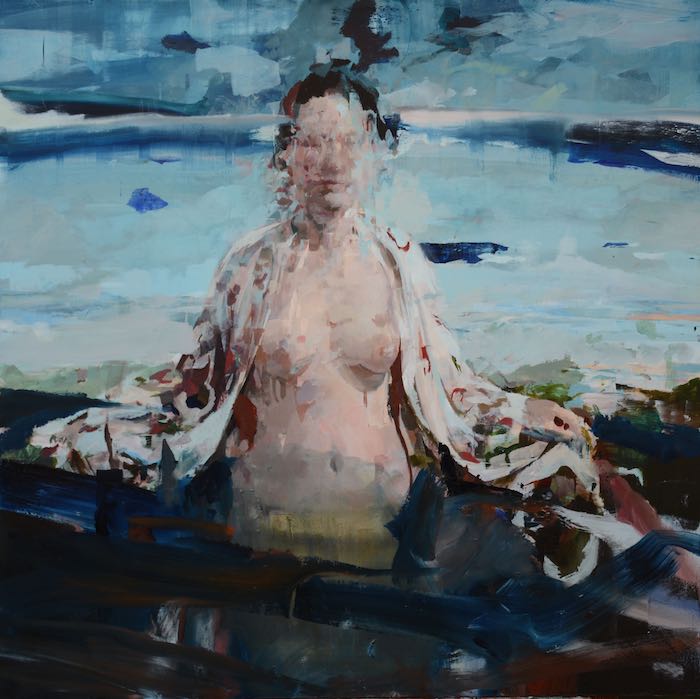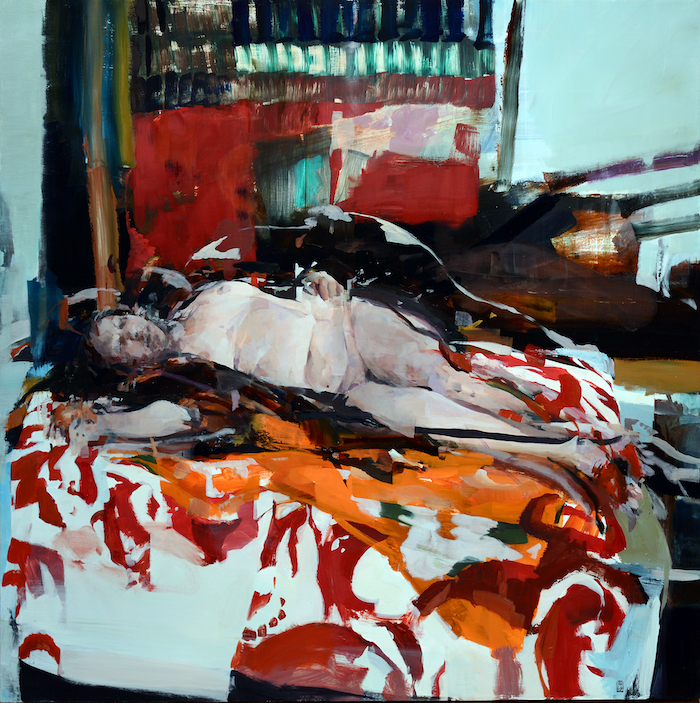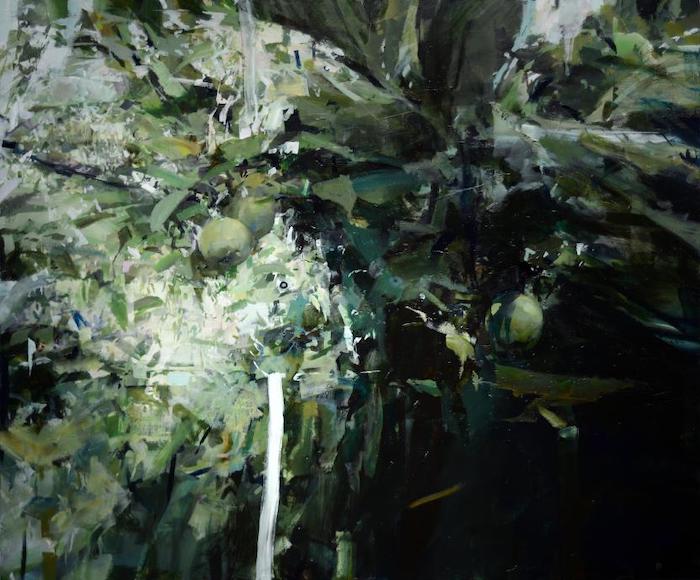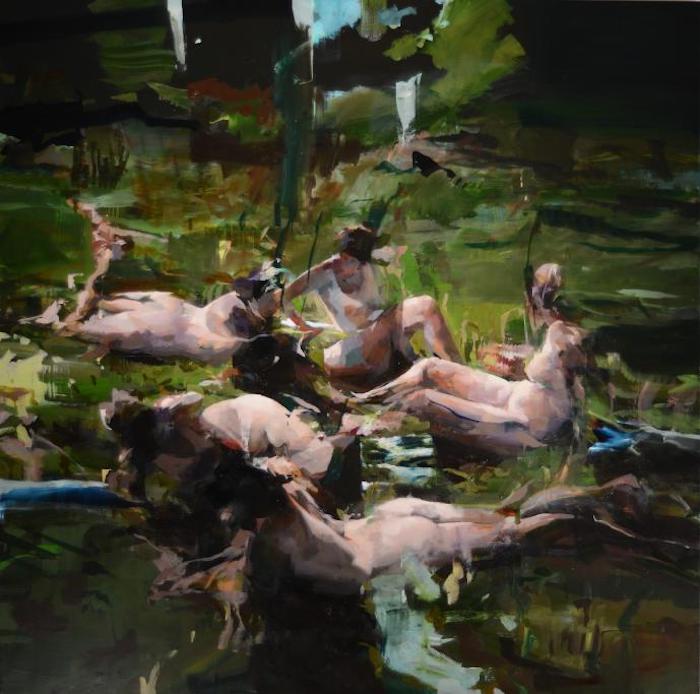Alex Kanevsky’s exhibition of new work at Dolby Chadwick Gallery focuses on the human figure. Whether lying on a bed, sharing a meal, or riding a horse, each subject appears in syncopation with their surroundings. Each painting comprises still life, landscape, and portrait. Interior and exterior are mutable as subject and environment exist in a shared space. Color and marks flow like air, light, and water to bind the animate with the inanimate through splotches, drips and blurs.
Lulu with Friend, 2019, presents a woman seated in a field of rich crimson, which washes over both what looks to be an arm chair and the body of the “friend” whose form is draped around her hips. Shades of red also form her headdress, dapple her arms, and flutter in the distance. Similarly, the sky, which in some areas suggests being viewed through a window, is a contradiction as it floats across her face and shoulder like little clouds, before shimmering straight down, beyond the bottom of the canvas. Foliage behind the woman could be as close as a house plant though it harmonizes with a receding ocher field in a sweep of green and slanting marks that might be trees in a vista beyond.
The woman is unclothed but for the head wrap. As with several of the paintings, there are references to iconic works of past masters, intriguing as more than a nod to precursors. It is where Kanevsky takes them that’s most distinctive. Something in the woman’s gaze, the silhouette of the scarf, and the mysterious smoky peak in the background evoke Jean Auguste Dominique Ingres’ Vesuvius, as though the tensile strength in Ingres’ portrayal of a serenely calm woman in the presence of a looming natural disaster has been shattered and rebuilt, expanding our engagement with both works.
Kanevsky’s paintings are humanizing. From his hand, the surreal and subconscious resolve into a strange liquid beauty, so musical in their changing pace and tone harmonics. They are poetic in their line breaks and remixing of painterly language. Take the painting, JH, 2020, in which vibrant orange falls across the bed. Is this a serendipitous wash of sunlight or an element of the fabric? With a certain physical thrill from the intensity of the gesture, as though the painter is tossing us a gorgeous bolt of color, who cares if it’s “real,” when the possibilities of imagination delights our field of vision? Orange helps us notice its complementary hue, the soft blues at the edge of the bed. A child might color the sun orange and darkness blue. Illumination and depth have arrived, regardless.
Large Apple Tree, 2020 offers a fugue of sun and shade woven through vibrations of branch, leaf, and fruit. Listen long enough to its contrapuntal patterns and it becomes a meditation, an allegory, an invitation to grapple with what is unseen and unspoken within ourselves as well as the work of art. This is the essence of poetry. Here are the opening couplets of a polyphonic poem by Paul Celan:
Aspen tree, your leaves glance white into the dark.
My mother’s hair was never white.
Dandelion, so green is the Ukraine.
My yellow-haired mother did not come home.
(translated from German by Michael Hamburg)
The suggestion is not that there’s a direct linkage between Kanevsky’s lyrical tree and Celan’s lament for his mother’s brutal death, but rather that both men reinvent their chosen artistic language to uncover depths of human emotion. Lived experience is far more variegated than what the eye is trained to see or the ear to hear. Great artists open these doors of perception. It is worth noting the size of this painting (60 x 72 inches). For those unable to see this exhibit live, imagine entering its presence and visa versa. 
The paintings are serious but never somber, as when Kanevsky’s curiosity and humor emerge in the provocative Friends with a Bird, 2020. How does a painting of two naked, entwined women on a bed, both holding the gaze of the viewer, manage to distract our attention with the small unframed picture of a turkey on the wall above them? This turkey that becomes intrinsic to the scene! Complicit in our voyeurism, it also is intrinsic to the success of the composition and assignation itself. What led Kanevsky on this detour? Did he find the stark wall boring? Was he looking for a way to pull the color from the bedspread up to a vanishing point? Or, was he simply being playful? The curiosity is now ours to entertain.
Though the majority of work focuses on centralizing an individual or duet, there are a few compositions in which larger groups of people appear. Dinner with Dear Friend, 2020 depicts a dinner party underway in the bottom half of the painting. In the upper realm a woman reclines on a large ottoman with oranges in her hands, at her sides, and across her lap. Upside down from the perspective of the party goers, it’s as though she’s floating above them. But if the painting is spun around, it’s the diners who levitate from the ceiling and we notice what may be a face, a light, and even a serving tray coming through the dark space of another room behind the supine woman. Within this strip of darkness is what connects both scenes, we wonder if the woman is dreaming of the people below or the object of the dinner party’s discussion. Perhaps the artist simply turned a discarded or in-process work upside-down to start something fresh. The mystery is much like the labyrinthine riddle of a Jorge Luis Borges tale, but what a treat to witness the pattern of Kanevsky’s mind. Delusion, illusion, or diversion are infinitely more interesting than what poses as everyday reality.
The question of how human beings decide what is real has fascinated prophets and philosophers, lunatics and lovers, scientists and artists through the ages. Atoms are so much smaller than the wavelength of visible light that they can’t even be visualized through a microscope. Yet, though they are technically invisible, they do have observable effects, such as the jittery dance that can be seen from the collision of individual water molecules on particles of dust. This opens up the time-lapse quality of Kanevsky’s paintings to the notion that they may approximate the scrambled secrets of imperceptible actualities rather well.
The exhibit’s title Scrambling for Grace echoes this strange time in which many of us struggle for a stillpoint in which to take a long breath from the barrage of disasters. Behind and between these anxious moments lies a quest to find a deeper flow beneath the blur of peripatetic modern life. The word scrambling also mirrors the creative process, the rough climb from initial concept to the summit of completion (or at least peace with the end point). In Kanevsky’s case, the resolution of this collision is a deft scrambling of elements to achieve an emotional climate and visual experience that not only captures the journey, but becomes the essence of his paintings’ power.
And what of the exhibit title’s reference to Grace? John Milton’s Paradise Lost portrays Hell, not as a place, but as a mindset. Milton uses Satan to embody the idea that hell exists only within by making despair his chief character trait. What frees the fallen Adam and Eve is the notion of Grace: the belief that we are worthy of forgiveness, not only by a god in his mercy seat, but by each other. The now-mortal couple finds paradise by opening their imaginations to possibilities beyond the present, freeing themselves from defeat by guilt, recrimination, and a sense of powerlessness.
So here we are: human beings who have set our Eden on fire; with some of us denying that the catastrophic loss of species, polluted ecosystems, and broken weather patterns are a problem. In Kanevsky’s Breakfast on the Grass, 2020. One’s first catch is Édouard Manet and the echo of Claude Monet’s response, but then the radiant light and seductive shades, lush tones, all that ancient green, glowing flesh, and crystalline blue take over. It’s heartbreakingly lovely for being so vanishingly alive. This is the paradise from which we would wish never to fall.
Kanevsky offers his viewers momentos of insight and encounter as they slip through his fingers into ours. The illusion of separateness is ruptured not just within the field of the canvas but beyond. —Tamsin Smith
Alex Kanevsky's Scrambling for Grace is on view at Dolby Chadwick Gallery from October 1 — 31, 2020




